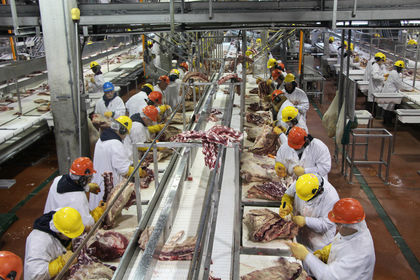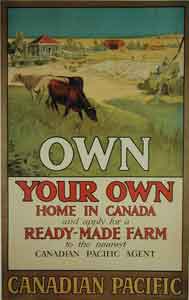“We need to continue to build public support for immigration as an
essential part of nation-building”
-Ratna Omidvar,
Canadian Senator (2017)
“What we want is population… Let them all come in. There is work for all. Every two or three men that come to Canada and do a day’s work create new work for someone else to do”.
-Cornelias Van Horne
President of CP Rail (1906)
This Sunday’s Globe featured a story about immigration to rural Canada.
The discussion was of one-industry towns like Brooks, Alberta, which have benefited from international immigration. In this article I consider three reasons why and (and how) immigration might benefit certain communities so much.
1. Immigration can be made more successful by actions at the community level
Journalist Parkinson (2017) points to two needs for successful rural immigration (here)
- immigration policy and plans to meet the change in economic needs of communities like Brooks
- Need for integration
a. matching the people moving into a community with the available jobs
b. having residents and businesses continue to welcome new people into the community
Strong rural communities can offer strength in the welcoming process.
2. We can increase immigration to certain areas in response to population decline
Our country has the space and arguably the need for people to move here from other countries, especially in our rural communities.
My classmates and I are familiar with the usual trends in rural population…
-out-migration of young people to urban centres
-low birth rates are exceed by the death rates of an older rural population
As Parkinson points out, there are entire provinces in Eastern Canada experiencing population decline, and there are communities throughout the country facing the same thing.
*** If you’re interested in demographics and immigration ***
see this short StatsCan video on demographic trends in
Canadian provinces.
A Statistics Canada Minute – Regional Demography
3. Available labour positions can be a starting point for new residents
Not unrelated to rural population decline, rural industry in Canada is changing. Of course it is! But though we may logically be expecting our old manufacturing and processing industry to move to other countries with cheaper labour, that’s not the only thing that is happening.
In Brooks, Alberta, the town meat-processing plant, the biggest employer in the area, underwent huge development in 1996. The plant grew, the labour needs increased, and the meat-processor required 2.5x its former number employees. That is 2500 people, a quarter of the Brooks population at the time.

So the municipality made the decision to promote immigration in their town. To start, people from other countries were encouraged to move to Brooks and work as labourers in the meat plant. Many people did move there and work at the plant for a time.
Many new residents eventually left their labour jobs in favour of more enjoyable work in town; with a more diverse population developing in Brooks, a market arose for different restaurants, stores and services.
What’s more, with an increasing population size, the town had more needs to fulfill. Professionals in medicine, public service, and civil engineering are working in Brooks like never before. The town continues to seek such professionals internationally.
Immigration continues to be a topic of research in rural geography and rural “development” (see last week’s recap of the symposium). I know some of my classmates have learned a bit about this topic, and I would love to hear from anyone about it.
MT

A note about the resources from this article
Parkinson, D. (2017, Feb 18). Case Study: Brooks, Alta. Globe and Mail. Toronto, ON, Canada.
A Globe and Mail piece from this past Sunday.
University of Guelph students can access the article online for free by searching the article title in Canadian Newsstream. Just be sure to sign in to the library webpage beforehand.
Thompson, B. (Producer), & Inkster, D. (Director). (2007). 24 Days in Brooks [Motion picture]. Canada: NFB. Available at https://www.nfb.ca/film/24_days_in_brooks/
A 2007 film by the NFB about the changing industry and society of Brooks, Alberta.
(I haven’t watched all the way through, so if you want to see it let me know and we can watch together!!)

At the rural symposium Palluk Arora discussed the experiences of immigrants living in rural Ontario. She brought up a variety of issues and concerns some of which you addressed in this blog post. Palluk discussed that a major concession that immigrants to rural areas made was social life and community. I think that even if immigrants are welcomed into a community they have a difficult time integrating. From her presentation it seemed that a lack of shared culture was a part of this exclusion that immigrants felt. I think that one of the reasons that immigrants move to major city centres like Vancouver and the GTA isn’t just for the economic opportunities but its primarily because of the distinct national communities and cultural necessities that make adjusting to life in a new country more comfortable.
I know that if I was moving to a new country I would want to have a community around me that spoke English and that access to my own culturally appropriate foods existed.
Can this happen in rural areas? Can there be many stores accommodating various cultural diets, is there room for a variety of community centres that allow the celebration of holidays from an array of nations?
One response to this problem is to try to incorporate a multicultural attitude into existing rural infrastructure. I personally think that this would be ideal, it would facilitate more understanding and cohesive community building as a whole.
In urban centres immigrant communities form hubs, an example in Vancouver is a large Indian population in south Vancouver, while just across the Fraser river in Richmond there is a large Chinese population. I am curious if this organic geographic segregation of immigration could benefit rural areas. Maybe instead of encouraging immigration as a whole, different rural communities could become immigration destinations for specific nationalities. That way the provision of cultural necessities could be more feasible.
LikeLiked by 1 person
Hey Jake,
Thanks for your thoughtful response (about 5 weeks ago- whoops)!
I think some of the questions you raise are really important! In terms of local stores providing access to culturally appropriate food- look at the case of Brooks, Alberta. Whereas people immigrated to the area to work a specific job with the meat processing plant, they didn’t all keep those positions at the factory. Instead, people started opening businesses to meet the needs of the new residents. Those new restaurants and shops can provide culturally appropriate foods and goods to people of different cultures entering Brooks.
I think this is not a perfect system- having a municipal economy centered around the one processing plant doesn’t scream sustainability to me- but I think the options for diversification are there. With increasing population, and increasing services, an area like Brooks could develop a remote computer work industry, for example. Or the town could support more manufacturing and retail for residents in the surrounding area.
I guess what is unique about this immigration situation, is that a large number of new residents entered Brooks at the same time. Lots of people were experiencing similar changes through the shared process of settling down in a new place. And like you said, lots of people moving into this area had shared components to their cultural backgrounds. So their cultural needs -those places to gather and celebrate- could be met communally. I don’t know that typical immigration into a particular area follows the same path, but based on your point about different parts of big cities being home to people of specific backgrounds it makes a lot of sense for rural areas to similarly become hubs for specific cultures.
For another example we can look at temporary immigration to rural areas. Our temporary foreign labourers for example, are pretty significant groups of people entering a rural area at one time. In these rural communities, like Sofia was saying on our field trip, those culturally appropriate foods start to be made available, because there’s a fairly large, if temporary, market of people to buy them.
LikeLiked by 1 person